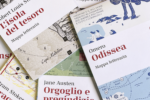Gianfranco Baruchello – 1962-1978 ventiquattro opere
.jpg)
In mostra nucleo di ventiquattro opere storiche, che abbracciano gli anni dal 1962 al 1978, significativo per il delinearsi del suo linguaggio fino a una completa e complessa definizione.
Comunicato stampa
La mostra dedicata a Gianfranco Baruchello – ideata con l'amico Mauro Panzera che, recentemente scomparso, non ha purtroppo potuto seguire lo sviluppo del progetto – si focalizza su nucleo di ventiquattro opere storiche, che abbracciano gli anni dal 1962 al 1978, significativo per il delinearsi del suo linguaggio fino a una completa e complessa definizione.
Attraverso la riduzione o meglio la miniaturizzazione di sistemi complessi, Baruchello su bianchi ma elaborati fondali, dà sostanza al suo Microcosmo, in cui gli elementi sezionati e ricostruiti sono definiti con miniata esattezza. Questa ricostruzione onirica e ironica, dettaglio infinitesimale dell'elemento insignificante o banale, si distende su una superficie policentrica: ogni singola minuzia, centrale e periferica a un tempo, tende a spezzare la visione d’insieme e accresce il senso di incertezza e di indeterminazione.
Questa miniaturizzazione dell'immagine è “...frutto di una dialettica fra enciclopedia e anarchia, spirito cartesiano e quello duchampiano, tentativo di sistemazione e impossibilità a realizzarlo. Il mondo si può assemblare attraverso dettagli che però non possono restituirci unità e totalità. E' possibile fare enciclopedie del presente, ma sommarie e provvisorie...” per dirla con le parole di Achille Bonito Oliva che insieme a Carla Subrizi hanno curato esposizione e catalogo per l'esemplare mostra del 2011 alla GNAM di Roma: Baruchello. Certe idee, in cui emerge la fondamentale importanza di artista e intellettuale complesso e “multimediale”, che ha abbracciato ogni modalità espressiva (pittura calligrafica, produzione di oggetti, testi letterari, teatrali, film, videotapes, fotografia, operazioni agricole) fino al pieno sconfinamento nell'azione sociale, di cui questa nostra mostra cerca di evidenziare in modo sintetico un particolare aspetto.
The exhibition devoted to the historic works of Gianfranco Baruchello was envisaged by our friend Mauro Panzera whose recent passing meant that he was unfortunately not able to follow the project to its realisation. On this occasion, albeit well aware of the importance of Baruchello’s recent oeuvre, we have tried to put together a series of twenty-four pieces from 1962 to 1978. The compositions embrace the fundamental period of his activity when his first works came together, and he acquired his own precise code of expression by shattering or rather ‘reducing’ the world into pieces. Sectioned and rebuilt in an almost miniaturist manner, the pieces crystallise and take shape on a ‘neutral’ white background to increase the feeling of uncertainty and indefiniteness of this oneiric and ironic, yet at the same time extremely detailed, reconstruction of an insignificant or banal element.
This miniaturisation of the image is ‘... the result of a dialectic between the encyclopaedic and the anarchic, the ésprit of Descartes and Duchamp, an attempt to render systematic and the impossibility to do so. The world can be assembled through details which, however, cannot give us unity or totality. We can make encyclopaedias of the present, but all they can do is provide a makeshift summary... ’ to use the words of Achille Bonito Oliva who, together with Carla Subrizi, curated the exhibition and catalogue for Baruchello. Certe idee, the classic 2011 show at GNAM in Rome. It was a show that cast light on the fundamental importance of this complex and ‘multimedia’ artist and intellectual who embraced all modes of expression - calligraphic painting, production of objects, literary texts, theatre, film, videotapes, photography, running a farm – leading him to cross over fully into the field of social action. And now our exhibition tries to sum up and highlight a particular aspect of his endeavour.



